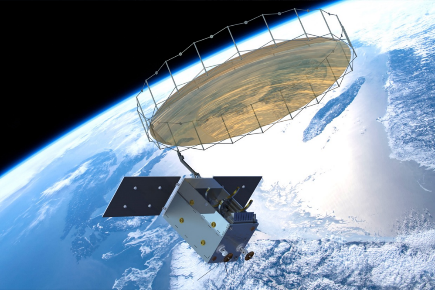
The payloads will be developed and built by Norwegian suppliers, while the satellite bus and the radar antenna will be built in the UK. The first satellite will be launched early 2025. In the following years, the plan is to launch a number of radar satellites to establish a constellation.
The satellite system named MicroSAR is unique in the way it can detect relatively small vessels in a very large area simultaneously. As of today we don’t know about any radar satellite systems with the same mix of capabilities.
Norway’s sea areas are seven times larger than the Norwegian land area. The Arctic and the High North is Norway’s most important strategic area of interest. This puts strong requirements on situational awareness in these areas. AIS (Automatic Identification System) has for many years been used for maritime surveillance. The challenge is that AIS is a system that requires the vessels themselves to send the required and correct AIS Information. Hence, AIS is a system based on cooperation. Today we estimate that 5 % of the vessels either does not send out AIS Information or are transmitting false information. Satellites with a radar, such as MicroSAR, will be able to detect these vessels independent of the use of AIS. MicroSAR satellites will bring an AIS Receiver to correlate radar detections with AIS Information.
The MicroSAR System is optimized for covering Norwegian needs. However, it will also offer and deliver maritime surveillance services in a global market in the same way as other radar satellites in space today, including surveillance of ship traffic, combating illegal fishing, search and rescue and oil spill detection.
Space Norway works closely with the Norwegian Armed Forces who will be the main customer and buy services and products from MicroSAR when in operation.
Space Norway also work in close cooperation with Kongsberg Satellite Services (KSAT). KSAT establishes, operates, and owns the MicroSAR Ground System, utilizing their existing global network. On behalf of Space Norway, they will provide services related to satellite operations and downlink of MicroSAR data. KSAT will also be responsible for marketing and sales of MicroSAR services and products as part of their portfolio, both in a national and an international market.
The Satellite System will be owned and controlled by Space Norway. This gives Norway an important strategic independent capability under national control to cover their needs for maritime surveillance.
Space Norway has signed contracts with the following vendors to build the first MicroSAR Satellite:
Surrey Satellite Technology Ltd (SSTL) is a UK company with long experience in building satellites. SSTL will deliver the satellite platform and be responsible for integration of the payloads on board. SSTL will also be responsible for building the radar antenna through their sub-contractor Oxford Space Systems (OSS).
For SSTL this builds on its experience in designing and operating small radar missions which was gained from the NovaSAR-1 spacecraft, a mission strongly supported by the UK Space Agency, which was put into operations in 2018 and continues to serve five major customers around the world. SSTL and OSS have also been working on small radar mission products, and OSS recently announced its wrapped rib SAR antenna also developed with UK government support.
The payloads will be developed and produced by the Norwegian companies WideNorth, Eidsvoll Electronics (EIDEL), Kongsberg Seatex and Norwegian Defence research Establishment (FFI). Hence, the project will also contribute significantly to business development of Norwegian companies.
Space Norway’s current plans are to launch the first satellite on a SpaceX Falcon 9 as a Rideshare. When establishing a constellation, the satellites will be launched on dedicated launchers. The establishment of Andøya Spaceport may result in future MicroSAR satellites being launched from Norway.
The MicroSAR satellites will follow polar orbits in various orbital planes at an altitude of about 600 km and will weigh about 300 kg.
This is Space Norway
A range of important and critical functions depend on information from satellites. Space Norway’s role is to manage and develop strategic space infrastructure to serve important Norwegian societal needs. Space Norway provides infrastructure services at wholesale level to a limited number of major customers, who in turn serve a wide range of end customers. The company is 100% owned by the Norwegian Ministry of Trade, Industry and Fisheries and represents a key part of the Norwegian Government’s activities and assets in the space sector.
The Space Norway group comprises the holding company Space Norway AS including the 100% owned subsidiaries Statsat AS and Space Norway HEOSAT AS (HEOSAT), as well as a 50% ownership in Kongsberg Satellite Services AS (KSAT).
Space Norway owns the fibre cable between the Norwegian mainland and Svalbard. The company has at its disposition the satellite link from the Norwegian satellite station Troll in Antarctica between Telenor’s Thor-7 Satellite and back to Norway. Statsat AS also operates the satellites AISSAT-1, AISSat-2, NorSat-1, NorSat-2 and NorSat-3. Space Norway HEOSAT are building two communication satellites delivering broadband to the Arctic (Arctic Satellite Broadband Mission – ASBM).
Read more about Space Norway on www.spacenorway.no/en/
Point of Contact:
Dag H Stølan
Director Security and Infrastructure / Space Norway AS
tel: +47 400 29 601
e-mail: dag-hugo.stolan@spacenorway.no
About SSTL
Surrey Satellite Technology Limited (SSTL), headquartered in Guildford, UK, is at the forefront of space innovation delivering customisable complete mission solutions for Earth observation, science, communications, navigation, in-orbit debris removal and servicing and exploration beyond Earth infrastructure.
Since 1981, SSTL has built and launched 71 satellites for 20 international customers, as well as providing training and development programmes, consultancy services, and mission studies for ESA, NASA, international governments and commercial customers.
SSTL is well known for innovative missions such as the CARBONITE satellites, the NovaSAR S-band radar imaging satellite and the RemoveDEBRIS space debris removal technology demonstrator.
Contact: Andrew Greenhalgh – Head of Marketing. Email: Agreenhalgh@sstl.co.uk